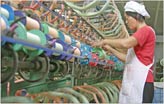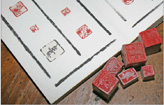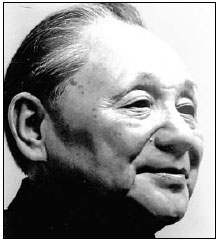People
Sculpting in time
Updated: 2011-06-16 08:09
By Xu Junqian (China Daily)
|
Wax sculptures of leading figures at the First National Congress of the Communist Party of China, held in Shanghai in June 1921. Photos Provided to China Daily |
 Er Baorui (right) and his wife (left) with a sculpture of former Chinese leader Jiang Zemin. |
|
A wax sculpture of Deng Xiaoping. |
Er Baorui breathes new life into famous figures of the past with his waxworks. Xu Junqian reports.
Acramped apartment on the outskirts of Tianjin is a human body shop for some of the most famous figures in China. A disembodied head with a signature mole under the lip sits on a lonely table, the only piece of furniture in the dark and grim living room that is shielded by bottle-green curtains all day long.
Locks of hair, pairs of limbs, even an odd limb or the trunk of a body are scattered all over the floor. The stuffy space is filled with the smell of burning wax and leftover lunches.
"Hand me a screwdriver and the right leg," a bookish-looking man with a pair of square glasses on his nose yells to his assistant.
But make no mistake - nothing untoward is happening in this approximately 100-square-meter studio of Er Baorui, the 62-year-old artist, who asked for the leg.
The Tianjin native is China's top wax sculptor and the first and only wax sculptor in the world to be honored as "The International Master of Fine Art" by UNESCO.
Over the past two decades, he has sculpted former leaders, such as Mao Zedong, in wax five times. He sculpted Deng Xiaoping twice and also rendered nearly 200 other prominent figures from both home and abroad. His wax immortals grace galleries, museums and monuments all over the country so that millions of people in China can touch, photograph, and, once in a while, hug their heroes.
Bringing a wax figure to life, however, is no easy matter.
"Waxworks are by no means all wax," says Er, who picked up drawing as a childhood hobby when he was 3 and later became an art professor at Tianjin Academy of Fine Arts.
Sketches are drawn first, from which clay figures will be modeled. Then wax is poured into a mold and a finished figure is produced. At the same time, the costume, accessories, background and other details must be considered and arranged, so these lifeless figures can blossom in their waxen beauty.
The process of "planting" hair or a beard is one of the most painstaking steps. A needle is used to insert each strand of hair into a slab of wax and then the hair is trimmed or shaved to the necessary length.
"The sculptor is the most important person in the workroom. The sculptor is not just an artisan, but also a director, a costume designer, and last but not least, a laborer, who has to carry these waxed figures each of which weigh several kilograms," Er says.
For example, when creating wax sculptures of the 15 people at the first National Congress of the Communist Party of China (CPC), which took place in June 1921, in Shanghai, Er drew hundreds of sketches to show the positions of the various figures and to give an idea of the desired effect.
"No photos are available of that confidential meeting. But instead of making it a solemn event like Leonardo da Vinci's The Last Supper, which is the most common approach taken by oil painters and artists in the country to represent the scene, I decided to give it an air of vivacity and passion," Er says.
"After all, it was a revolution - and definitely a successful one," adds Er, who is a senior member of the Chinese Democratic League, one of the eight recognized political parties in China, and "a close friend and a resolute supporter of the CPC", as Er puts it.
While figures in Madame Tussauds, the world's best-known gallery of life-size, realistic wax sculptures, are usually created with the help of the real-life celebrity, who may appear at the sculptor's studio to be measured, the wax politicians made by Er are created from pictures and words.
"Like most people in China, I don't have any direct experience of these great figures. But to convey their every wrinkle and smile vividly, I refer to as much video footage and as many photographs as can be found."
After considerable early preparatory work, it usually takes around three months for Er to finish a sculpture. "Certainly, I want to take it slowly and allow myself more time to achieve perfection. But waxworks in China are not as popular as other art styles, like painting, which have quickly gained momentum in the global market by selling for millions of dollars a piece," Er says.
"Most wax sculptures are ordered by museums and galleries that have a low budget, and I am one of the few people doing it," he says.
His first wax sculpture was a statue of a Qing Dynasty (1644-1911) emperor for an archeological site near Beijing to help attract more tourists, which he did in 1992.
Er recalls that when a photo of the wax sculpture of former leader Deng Xiaoping, was shown to his family members, it was so true-to-life that Deng's daughter, Deng Lin asked when the picture was taken of her father and suggested it was used in the future.
"Asian people are, generally, more difficult to sculpt because of their relatively flat facial features. And when it comes to household names like Deng or Mao, it's like snow on frost. Everyone in the country knows exactly how they look," Er says.
One of the secrets of his success is attention to details, such as wrinkles, freckles and even pores, which were previously not taken into consideration by artists at home or abroad.
"When I was first assigned waxwork commissions early in the 1990s, there was barely anyone or anything available at home for reference about the art of wax sculpture," Er recalls. "I was groping all by myself until a news article by a Chinese reporter came to my attention, which said the wax sculptures made by foreign artists were so real even the pores could be clearly seen on the skin of the figures."
That, of course, was an exaggeration by the Chinese reporter, who knew little about waxworks. The skill of making pores in wax is yet to be accomplished by artists in European countries like the United Kingdom, which has a history of more than 200 years of wax sculpture art.
But Er threw his heart and soul into achieving what he anticipated would be an "essential international skill for waxworks".
It is not all rosy in Er's garden, however. Er was supposed to have retired two years ago but has been so busy he has not been able to do so and has missed many of his family's most important moments, including when his father was on the brink of death.
"My father once joked that I make the dead alive and the living die," he says. "But I believe the spirit of these artificial figures is made with the blood and sweat of the artist."
Internationally, a wax sculptor usually charges $300,000 to make a sculpture. In China, the pay is less than 10 percent of that amount, even when it comes to masters like Er. "I am fairly rich compared to most of my colleagues at school. But I didn't do it for money. If I did, I could have been a billionaire years ago, considering my productivity and skills," he says.
"With regard to all the toil and the price I have paid, no money or material rewards can compensate. I can only be compensated by the sense of achievement from my audience's warm response," he says.
"Young people may not get it or may find it hypocritical. But for our generation, patriotism and gratitude to our Party is in our DNA. We were raised this way, in the same way young people today adore singers or movie stars," says Er, who was born in 1949, the same year as the founding of the People's Republic of China.
With the 90th anniversary of the founding of the CPC drawing near, Er is even busier than usual with orders flying in for "red" statues. In the future, Er says, he would like to take some time out to make a wax sculpture of ordinary people, like his mother or wife.
"I think it would be great fun," says the artist at the end of our two-hour-long interview, which he calls "a nice break" in his tight schedule.
E-paper

Pearl on the Yangtze
Wuxi is considered a town of natural beauty and its motto is "city of water and warmth".
Prose and consternation
Riding on a mystery train
Way of a warrior
Specials

When two are one
After a separation of 360 years, Huang Gongwang's famous Dwelling in the Fuchun Mountains has been made whole again.

Wealth of difference
Rich coastal areas offer contrasting ways of dealing with country's development

Seal of approval
The dying tradition of seal engraving has now become a UNIVERSITY major


